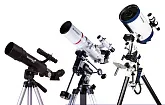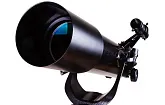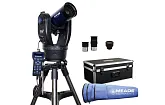Things you can see with a telescope based on its aperture
60-70 mm refractors, 70-80 mm reflectors:
- binary stars with angular separation of over 2", e.g. Albireo, Mizar, etc.;
- faint stars (up to 11.5 stellar magnitude);
- sunspots (with an aperture filter);
- phases of Venus;
- lunar craters (8 km in diameter);
- polar ice caps and maria on Mars during oppositions;
- atmospheric bands on Jupiter and the Great Red Spot (GRS) under ideal conditions, four moons of Jupiter;
- rings of Saturn, Cassini Division under ideal conditions, pink atmospheric band on the planetary disk;
- Uranus and Neptune as stars;
- large globular, e.g. M13, and open clusters;
- almost all of the Messier objects (not detailed).
80-90 mm refractors, 100-120 mm reflectors, 90-125 mm catadioptric telescopes:
- binary stars with angular separation of over 1.5", faint stars (up to 12 stellar magnitude);
- structure of sunspots, granulation and solar flares (with an aperture filter);
- phases of Mercury;
- lunar craters (5 km in diameter);
- polar ice caps and maria on Mars during oppositions;
- clearer view of atmospheric bands on Jupiter and the GRS, shadows cast by moons onto the planetary disk;
- Cassini Division in the rings of Saturn and 4-5 moons;
- Uranus and Neptune as small disks with no details;
- tens of globular clusters, bright globular clusters are resolved into cosmic dust at the edges;
- tens of planetary and diffuse nebulae and all Messier objects;
- brightest objects from NGC;
- some details are resolved on the brightest and largest objects;
- details are not resolved during observations of most galaxies.
100-130 mm refractors, 130-150 mm reflectors and catadioptric telescopes:
- binary stars with angular separation of over 1", faint stars (up to 13 stellar magnitude);
- details of lunar highlands and craters (3-4 km in diameter);
- spots in the atmosphere of Venus may be seen with a blue filter;
- numerous details on the surface of Mars during oppositions;
- features in the atmospheric bands of Jupiter;
- atmospheric bands on Saturn;
- plethora of faint asteroids and comets;
- hundreds of clusters, nebulae and galaxies;
- spiral features of the brightest galaxies (M33, M51);
- a large number of objects from NGC (features may be observed on most objects).
150-180 mm refractors, 175-200 mm reflectors and catadioptric telescopes:
- binary stars with angular separation of less than 1", faint stars (up to 14 stellar magnitude);
- lunar features (2 km in diameter);
- Clouds and dust storms on Mars;
- 6-7 moons of Saturn, planetary disk of Titan may be observed;
- Spokes in the B ring of Saturn, at the peak of visibility;
- Galilean moons as small disks;
- at such apertures, resolution is more dependent on viewing conditions, rather than practical power;
- some globular clusters are resolved into individual stars;
- with minimal light pollution most features of a number of galaxies and nebulae may be observed.
200 mm refractors, 250 mm reflectors and catadioptric telescopes (and beyond):
- binary stars with angular separation of 0.5" (under ideal conditions), faint stars (up to 15 stellar magnitude);
- lunar features (less than 1.5 km in diameter);
- small clouds and features on the surface of Mars, at times Phobos and Deimos may be observed;
- a large number of features in the atmosphere of Jupiter;
- Encke Gap in the rings of Saturn, planetary disk of Titan;
- Triton, moon of Neptune;
- Pluto as a faint star;
- viewing conditions have a great effect on the quality of produced images;
- thousands of galaxies, star clusters and nebulae;
- almost all of the NGC objects, faint colors may be observed in the brightest nebulae;
- finer details on many NGC objects.
|
Telescope |
The Moon, planets and their moons |
Stars |
Nebulae, galaxies and star clusters |
|
|
60-70 mm refractor, magnification 25-125x |
Solar spots (with an appropriate solar filter), phases of Venus, lunar craters (7-10km in diameter), atmospheric bands of Jupiter and four of its moons, rings of Saturn and Cassini Division under good conditions, Uranus and Neptune as faint green stars |
Binary stars with angular separation of 2", faint stars up to 11.5 stellar magnitude |
Large globular clusters, bright nebulae. Under ideal conditions all Messier objects may be observed |
|
|
80-90 mm refractor, 100-115 mm reflector, magnification 15-250x |
Structure of sunspots, phases of Mercury, lunar canyons and craters (5.5 km in diameter), polar ice caps on Mars, as well as highlands during oppositions, more atmospheric bands of Jupiter, shadows from its moons on the planetary disk, Cassini Division in the rings of Saturn and five of its moons, Uranus and Neptune as tiny disks |
Binary stars with angular separation of 1.5", faint stars up to 12 stellar magnitude |
Tens of globular clusters, diffuse and planetary nebulae, galaxies. All of Messier objects, the brightest NGC objects under good conditions, features of bright nebulae, galaxies, however, are viewed as bleak gray spots |
|
|
100-125 mm refractor, 150 mm reflector, magnification 30-300x |
Multiple lunar features, canyons, craters (3 km in diameter), highlands features on Mars, details of atmospheric bands on Jupiter, atmospheric bands on Saturn, multiple faint comets and asteroids |
Binary stars with angular separation of 1" (under good conditions), faint stars up to 13 stellar magnitude |
Hundreds of star clusters, nebulae and galaxies (spiral features may be observed in some galaxies), many NGC/IC objects under good conditions. Structure of nebulae and star clusters |
|
|
150-175 mm refractor, 200 mm reflector, 175-225 mm catadioptric telescope, magnification 50-400x |
Lunar features (less than 1.8 km in diameter), large clouds and dust storms on Mars, 6-7 moons of Saturn, 4 of the brightest moons of Jupiter at large magnifications (seen as tiny disks), multitude of faint asteroids (seen as tiny stars) |
Binary stars with angular separation of less than 1" (under good conditions), faint stars up to 14 stellar magnitude |
Many globular clusters are resolved into individual stars, many features of nebulae composition and structure of many galaxies |
|
|
250 mm (and above) reflector and catadioptric telescope |
Most of the time, atmospheric conditions prevent you from peering deeper into space with such telescopes, as compared to the ones with smaller aperture. However, under ideal conditions and with minimal light pollution, you can see lunar features (smaller than 1.5 km in diameter), tiny features on the surface of Mars and at times its moons, Phobos and Deimos, fine details of atmospheric bands of Jupiter, Encke Gap in the rings of Saturn, Neptune and its moon, Triton, Pluto may be observed as a tiny star |
Binary stars with angular separation of 0.5" (under good conditions), fait stars up to 14.5 stellar magnitude |
Thousands of globular and open clusters, most of the NGC/IC objects, detailed structure of galaxies and nebulae, faint coloration may be observed in some objects |
Any reproduction of the material for public publication in any information medium and in any format is prohibited. You can refer to this article with active link to levenhukb2b.com.
The manufacturer reserves the right to make changes to the pricing, product range and specifications or discontinue products without prior notice.
View related articles (3)

Frequently Asked Questions – Telescopes
This useful article includes some of the most frequently asked questions about telescopes and astronomy

A short guide to refractor telescopes: choose your equipment wisely
Learn everything you need to know about refractor telescopes to make the right choice

A quick guide for novice astronomers
This short guide will help you avoid typical mistakes and learn more about telescope and mounting types
